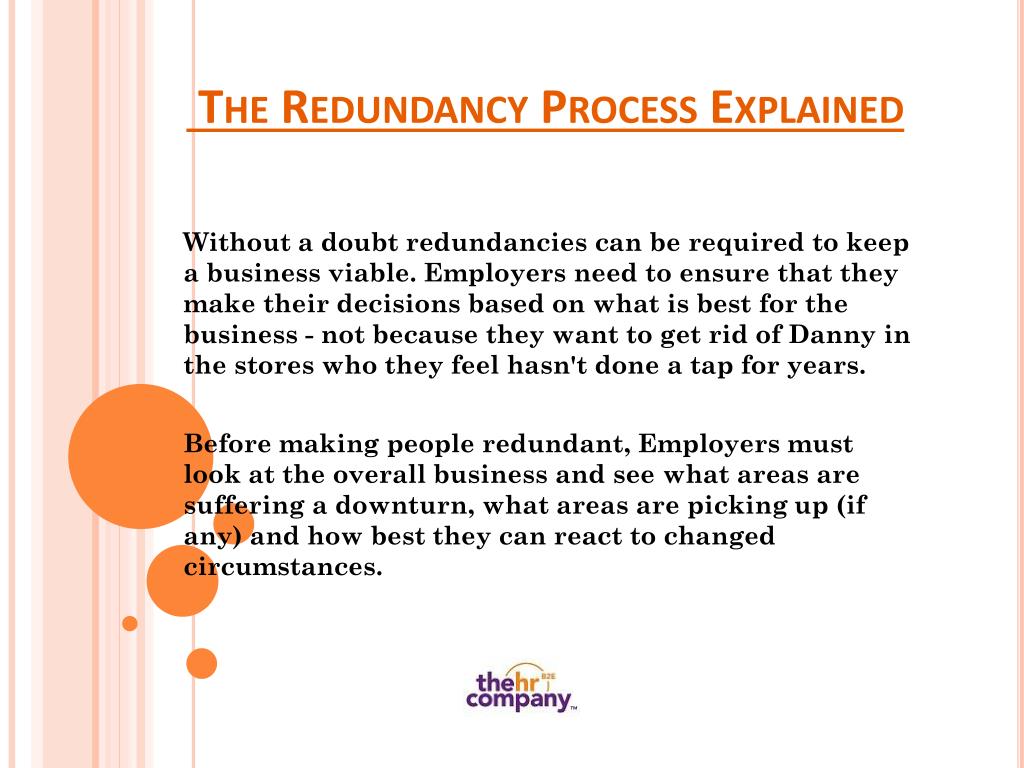What Happens to Redundancy If Company Goes Bust? An Overview to Your Rights
What Happens to Redundancy If Company Goes Bust? An Overview to Your Rights
Blog Article
Unboxing the Methods for Mitigating Company Redundancy and Enhancing Business Resilience
In today's vibrant organization landscape, the capacity of organizations to navigate unpredictabilities and obstacles is extremely important for long-lasting sustainability. Mitigating firm redundancy and enhancing organizational resilience have ended up being prime focus for leaders aiming to prosper and adapt in an ever-evolving market. By diving right into the complexities of critical preparation, labor force optimization, and technological combination, business can not just enhance their operations however likewise fortify their structures to withstand unexpected disturbances. As we explore the complex techniques used by forward-thinking organizations, a much deeper understanding arises right into the positive actions important for fostering agility and stamina despite modification.
Assessing Current Organizational Redundancies
To properly evaluate current business redundancies within a firm, a detailed evaluation of the existing processes, functions, and obligations is necessary. if a company goes bust who pays redundancy. By performing a complete exam of the various features and jobs lugged out within the organization, administration can determine locations where duplication of initiatives or inadequacies exist. This evaluation must not just concentrate on individual work roles but additionally consider just how various departments collaborate and communicate
One approach to assessing redundancies is to evaluate work descriptions and responsibilities to pinpoint any type of overlaps or spaces in obligations. In addition, analyzing the process and communication channels can disclose traffic jams or unnecessary action in processes. It is important to entail staff members whatsoever degrees during this evaluation to obtain understandings from those straight entailed in day-to-day operations.

Carrying Out Agile Workforce Approaches
Adhering to a detailed assessment of existing organizational redundancies, the execution of nimble labor force methods ends up being important for enhancing functional effectiveness and adaptability. Active labor force strategies entail developing a vibrant and versatile job atmosphere where workers can swiftly adjust to altering company requirements. One crucial aspect of implementing agile workforce approaches is promoting a society of continual knowing and advancement. This entails offering workers with the essential devices, resources, and training to obtain brand-new abilities and competencies. Additionally, companies can enhance dexterity by advertising cross-functional teams that can easily move and work together emphasis based on top priority jobs.
One more important element of dexterous labor force methods is advertising transparent interaction and empowering staff members to choose autonomously within their duties. By decentralizing decision-making procedures, organizations can respond better to chances and obstacles. Furthermore, adopting dexterous task administration techniques, such as Scrum or Kanban, can simplify operations and increase efficiency. Generally, applying active labor force strategies can help companies stay affordable in today's swiftly developing business landscape.
Leveraging Innovation for Effectiveness
Leveraging innovative technical solutions can substantially improve functional performance within companies seeking to simplify procedures and enhance resource utilization. By incorporating automation devices, expert system, and information analytics, business can improve operations, lower hands-on mistakes, and make data-driven choices promptly. Automation can manage repetitive tasks, permitting official site workers to concentrate on more strategic efforts, thereby boosting performance and innovation.
Moreover, the application of cloud computing solutions makes it possible for smooth cooperation amongst group participants, despite their physical place. This cultivates interaction, enhances project management, and boosts overall effectiveness. In addition, using consumer relationship monitoring (CRM) software can aid businesses better recognize their customers' needs, individualize interactions, and ultimately increase client contentment and loyalty.

Motivating Continuous Discovering and Development
Implementing a culture of constant knowing and advancement is crucial for promoting growth and flexibility within a vibrant organizational atmosphere. Motivating staff members to take part in recurring knowing chances read this post here not only enhances their individual skills however likewise contributes to the general resilience of the business. By prioritizing constant understanding, companies can stay abreast of sector trends, adjust to technical developments, and remain competitive out there.
To properly encourage continual understanding and advancement, companies can establish learning and development programs, offer chances for upskilling and reskilling, provide access to on-line training courses and sources, and create an encouraging knowing environment. Supervisors play a critical function in promoting a culture of discovering by leading by instance, providing comments and mentoring, and recognizing and compensating workers' knowing achievements.
Structure a Resistant Corporate Culture
Establishing a resistant corporate culture is extremely important for companies looking for to prosper and browse obstacles in an ever-evolving service landscape. A durable company culture is identified by versatility, openness, open communication, and a strong feeling of function. To build such a society, leaders need to focus on cultivating count on among staff members, encouraging partnership, and advertising a growth mindset. Transparent interaction regarding business changes, difficulties, and see successes is crucial in developing a society where staff members really feel informed and valued. Furthermore, providing chances for professional development, recognizing and rewarding employees' contributions, and promoting work-life equilibrium are crucial aspects of a durable company culture.
Leaders play a significant function fit the society of an organization. By leading by instance, demonstrating strength when faced with difficulty, and proactively supporting their teams, leaders can instill these worths throughout the company. A durable corporate culture not just aids firms stand up to challenges however also fosters innovation, enhances employee engagement, and eventually contributes to long-term organizational success.
Final Thought
To conclude, the approaches for reducing firm redundancy and boosting business resilience are important for maintaining competitiveness in today's vibrant business atmosphere. By assessing existing redundancies, applying dexterous labor force strategies, leveraging innovation, motivating continual discovering and development, and constructing a resilient corporate society, companies can adapt to alter, improve performance, and foster innovation. These aggressive measures will assist companies browse obstacles, decrease interruptions, and make sure long-term success in the ever-evolving market.
Following a thorough evaluation of existing organizational redundancies, the implementation of nimble labor force methods becomes essential for maximizing operational effectiveness and adaptability - if a company goes bust who pays redundancy. In general, implementing agile workforce strategies can assist business stay competitive in today's rapidly developing service landscape
A resistant corporate society not only assists firms endure difficulties yet additionally cultivates technology, boosts worker interaction, and eventually contributes to lasting business success.

Report this page